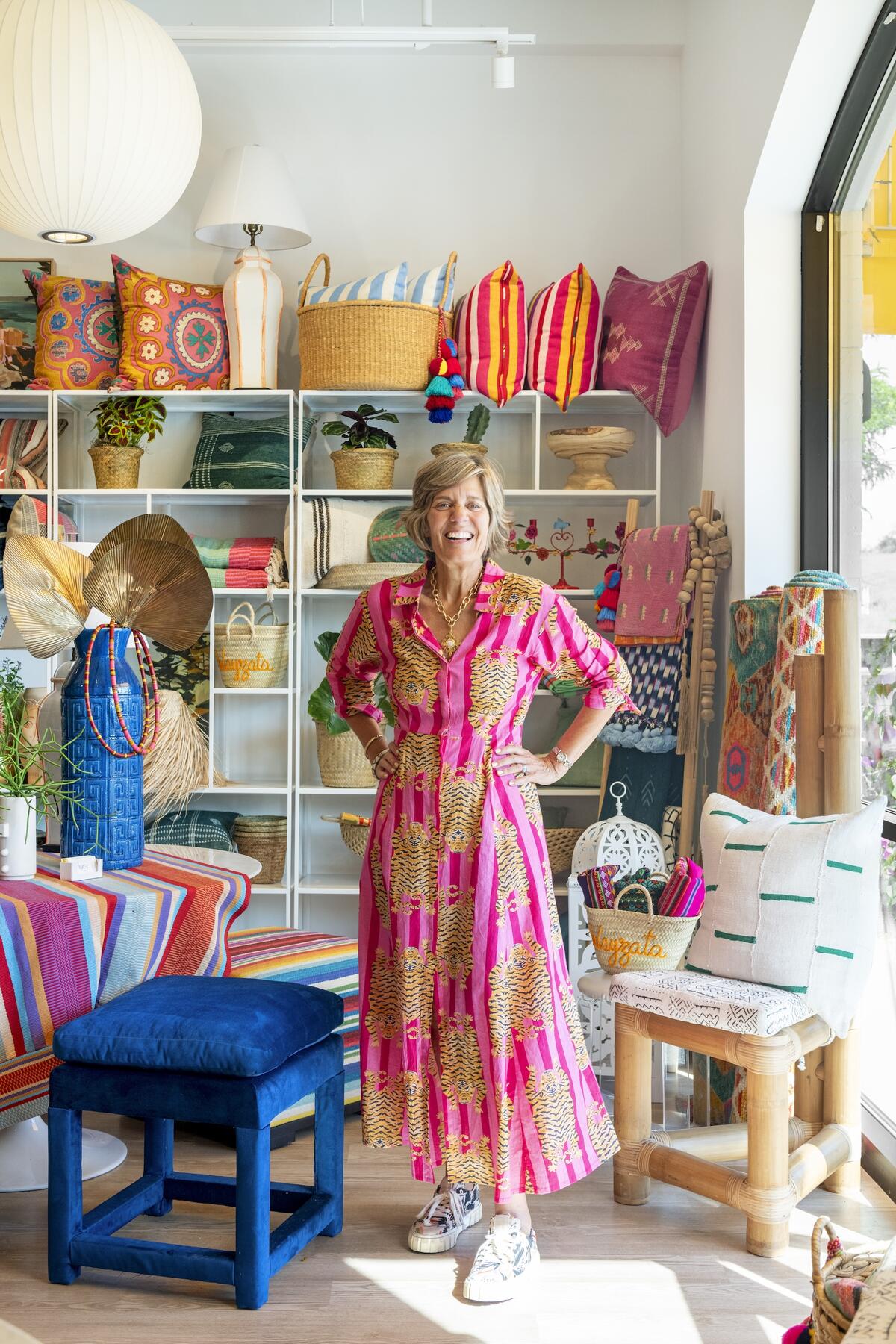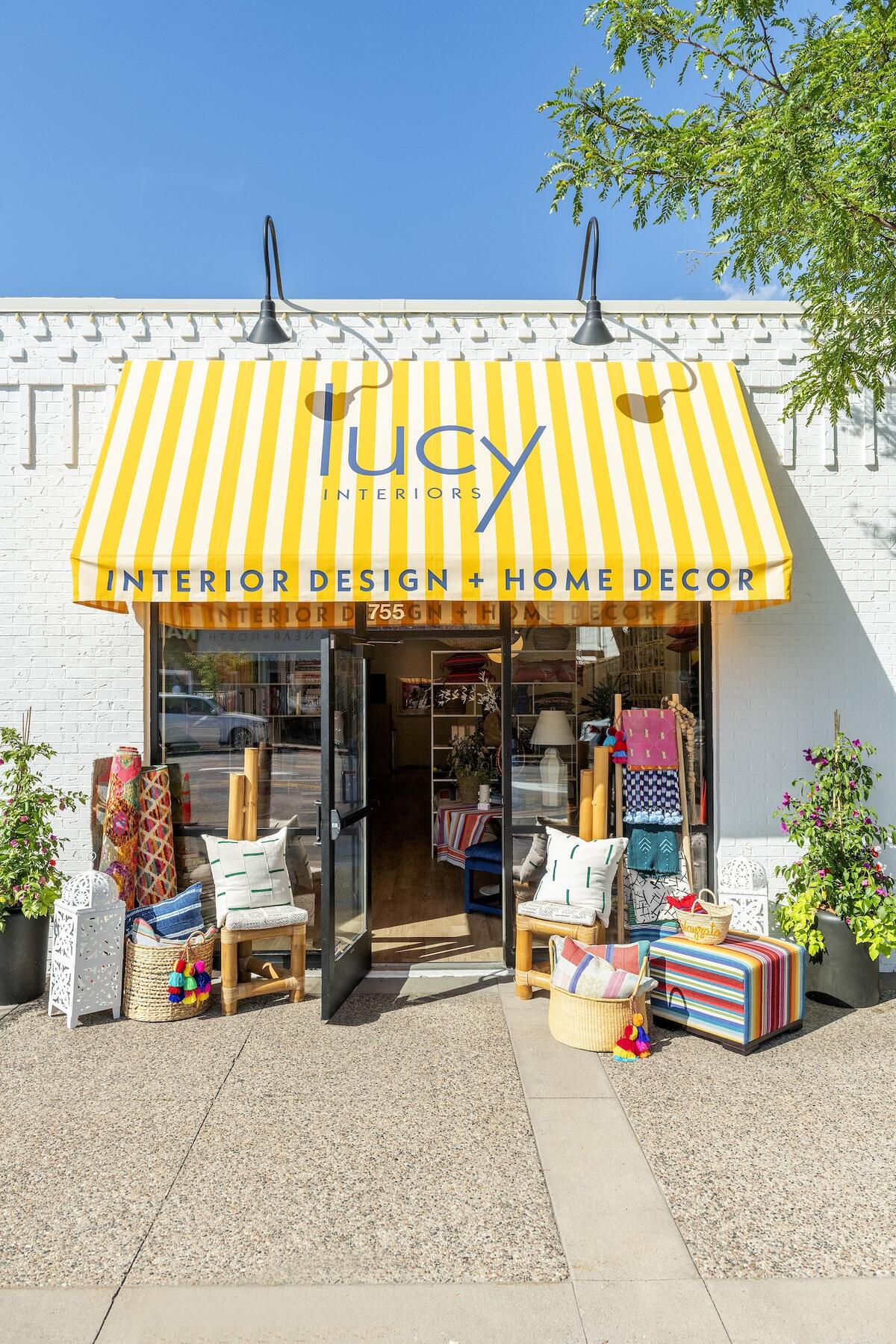In Business of Home’s series Shop Talk, we chat with owners of home furnishings stores across the country to hear about their hard-won lessons and challenges, big and small. This week, we spoke with interior designer and shop owner Lucy Penfield.
While her firm, Lucy Interiors, has offices in Minnesota and Florida, it’s the former where she operates a retail store: Wayzata is a village on Lake Minnetonka, less than 15 miles from Minneapolis; known for its boutiques, it’s a destination for shoppers—and it happens to be Penfield’s hometown. When she describes it, the place sounds like something out of Gilmore Girls, with a cozy community that adores her immensely chipper outlook on life (and design). Ahead, she explains why she decided to move home and talks about her pillow obsession and “dabbling daintily” in e-commerce.

Tell me about your career before the shop.
I got an interior design degree, and [one in] art history. I’m a color lover, a maximalist, [and an] over-the-top, adventure-seeking girl. I ended up not being able to find an interior design job right out of school, so I was in the fashion industry for the first 10 years of my career, which was fabulously exciting and dramatic. That started in Boston and Chicago, and ended in New York, working for a Hong Kong trading company and doing private-label [design] for luxury clients like Bendel’s and Bergdorf. I had always wanted to be in the field of interior design, but got segued into this wild Seventh Avenue New York craziness. When I was starting a family, I was like, “You know what? I want to go home to where my friends and family are.” We set up here, and I started working for my mentor; then I launched my studio in 2005.
When did you expand to Florida?
We started some of our first projects there, so these have been lifetime clients and projects, but it was in just the last several years that we launched the [Naples] office. We work all over the country, but it seems that for our Minnesota-based customers and new ones, Florida is where it’s happening. With all the wild weather, I don’t know that that’s going to be true forever, but [it is for now].
What is the aesthetic of the store like?
Well, it’s actually the storefront of our studio. It’s a small footprint—we call it the “pillow party.” People will walk in off the street and say, “Oh, it is so joyful in here! Who needs sunshine?” We’re full of color. It’s shelves all around. It’s very artisan-based. I’m a traveling collector: I love sustainably minded, one-of-a-kind textiles, and then I’ll custom-make pillows. I don’t buy collections or lines of pillows and textiles—or if I do, they’re remnants or upcycling. I love finding fabrics when I go to South Africa or Guatemala or Mexico. So it’s really cross-cultural, fun, unique pieces.
Tell me about your sourcing process. Do you use any of the online markets?
I love Faire. I think Faire has been fabulous as a shop owner. I don’t have the buying power or the interest to buy big quantities. They’re like little teasers, luring clients to come back for more. What I love about Faire is the reviews. It’s a wonderful platform for artisanal, small, crafted [items], and they don’t have high minimums. I can be in and out [with] something; if clients don’t like it, I can test the waters. I’m learning as I’m going.
Can you tell me about a relationship with a favorite vendor? If I’m going to ask you to play favorites …
I carry a fabulous artist, Heidi Libera, who created a special series of Paris florals for us and we’ve had them framed wonderfully. She’s developing a little something from her trip in Italy. Another wonderful source is Haines. What’s very cool is she works with a lot of the textile brands that we know, and when their patterns are discontinued or there are overruns, she buys them and recycles them and puts them back out into the market. That’s been a wonderful source.
What’s the neighborhood around the store like?
It’s layered with yummy foodie restaurants. And this is the other exciting thing: I’m a discovery, go-getter girl, and I never sleep. I’m always scheming up ideas. Early this year, right after I got on the street, we created what we’re calling the Wayzata Design District with nine independently owned home decor shops—no chains. We’ve had one event, in the summer, and it was just wonderful. We were out pouring cocktails and had nibbles, and I did a pop-up with one of my showrooms that represents a bunch of lines. On December 10, we’ll have a holiday market. We have friends up and down the street that are tastemakers of home decor—we also have The Shade Store and Anthropologie and Talbots, but most of us are independent. It’s lakeside, so it’s a very big sailing and boating and yachting community.

What about your own favorite category? What type of product do you really love?
Textiles. I was the [sample] librarian in both my internships in the design world, and I [loved] learning all of the fabric companies and what they’re known for—hand-blocked or interwoven, Jim Thompson silks. The only other thing is pillows—people say I have a pillow obsession. We probably have 200 one-of-a-kind pillows right now in our shop.
What is your approach to e-commerce?
I’m dabbling daintily. We use Squarespace for sales, but our e-commerce is not huge. Our sales are either our clients or walk-ins from the community, but 20 percent is on our e-commerce. It’s so much work—packing, shipping, getting it out. But I’m happy to do it because it builds the brand.
How did you learn about those processes?
By the seat of my pants. My managing director, Kari, is wonderful, and she’s dabbled a little more than I, and has [provided] good guidance. Then I seek good counsel from other friends and colleagues, and every Monday and Thursday [I listen] when The Business of Home Podcast comes out. [But even so] it’s such a struggle. But by the seat of my pants—that’s the true answer.
Do you ever worry about people “shopping” the store, as in checking things out and then googling them to see if they can find it cheaper online?
Yes, everything, every day. We cannot believe it, and especially as we’re developing all ages of clients. We’re too savvy; we are always benchmarking our pricing. If I’m buying something known, I would absolutely do the MSRP price. But I think that’s part of wanting to be unique and artisan—[we want shoppers to] come in and [have] a personal, new experience. I try not to represent typical lines. I couldn’t compete. In the Wayzata Design District, we’re all very true and faithful and mindful of each other. Even with my Faire artisans, I will check and ask, “Are you anywhere in Wayzata? [If so], I want to protect your business with them.” It’s a town of 4,000.
What are the advantages and disadvantages of operating in such a small town?
Two things: With the shop in front, I’m interrupted a lot during my day because we get a lot of action and customers coming in, so that can be distracting. I love it because I’m a people person. We have a sign that says, “Please pop in and see us.” We’re a very inviting community, but that’s distracting. The small size is crazy, because it’s a destination town. Obviously, it’s not Newport or Cape Cod or whatever, but it is a huge draw in Minneapolis. It is slow seasonally. After the holidays, it’ll wind down because we get a lot of clients heading to warmer climates or to their mountain house. But I’d say the shop, for me, is really my lead, or the hood ornament. It’s the little splash, the teaser, to invite you to come in and become a client.
How have you weathered some of the issues of the last few years—the pandemic, staffing, inflation?
With careful TLC. I would say my biggest and most important relationships are with my team. We call ourselves the Lucy crew. I worry and care so much about all of us. We have special lunches. We just celebrated an engagement yesterday. So I try to make sure that everybody is happy and feeling good and in a good place. We do a lot of nurturing that way. It’s been hard as a small business. Certainly this election year’s been crazy. We get in a little bit of a bubble with our high-end clients, but everybody feels it. We’re feeling it. It’s soft out there.
The other thing—when you were asking about the shopping. I think with Amazon, everybody gets everything in five minutes, and they can return it. I mean, our business is flourishing; we have grateful, wonderful clients. [But] we’ve had more than our share of, “I don’t really like that anymore. I’m going to return it.” [But with us], there’s no “return.” I mean, I custom-ordered it for you. So that’s tough for custom, one-of-a-kind, small entrepreneurs.
How do you deal with that?
It’s very difficult. Maybe it’s my nature; I’m a people pleaser, and I can also get run over. I never shove something down anybody’s throat, and I guess that’s why I’ve had clients for decades. But at the same time, I’m feeling the financial burden. I will [give them] a credit and say, “We’ll find something else,” or will comp our design time to make them happy. I need to be stronger, but it’s difficult for me.
Given all this, how do you feel about the future of small business? And how has your opinion changed since the pandemic?
I think it’s more important than ever, because we are building relationships and trust, and that makes us stronger. It isn’t just about a transaction. I think it’s going to take a lot of work and nurturing. As a designer, for my mentees—and I mentor a lot of emerging designers—it’s just saying, “Be a good human. Be honest.” Because it isn’t about the sofa you sell today, or the kitchen you helped design. It’s about raising a family together, getting to know each other, and showing empathy and sympathy. For small businesses to survive to where we are today, I think it’s necessary because of the relationships.
What is your favorite day as a shop owner?
People coming in, dogs walking by, friends popping in to wave. I’ve seen old classmates! I would say that the interaction of the community and being street side and hearing the door open.



























